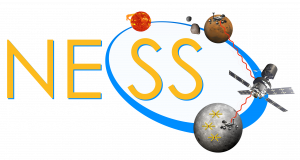How do near-infrared telescopes work?
Although they measure near-infrared light, rather than the optical light our eyes see, these telescopes operate in an analogous way to digital cameras (in fact, they can also measure optical light, albeit with different cameras). First, the telescope collects a great deal of light from a source (cameras use lenses; these telescopes are so large they use mirrors). Then, it focuses the light on a detector, which is a much, much more sophisticated analog of the sensor on a digital camera. One of the key advantages of ground-based telescopes is that they can be made very large. The largest telescopes today, such as the Keck Telescopes in Hawai’i, have mirrors about 10 meters across (or over 30 feet).
Image: Keck Mirror, Wide Angle
Credit: W. M. Keck Observatory
How does the atmosphere affect these observations?
Earth's atmosphere presents a number of challenges for astronomers. The first is that layers of moving air in the atmosphere act as tiny lenses, redirecting the light that passes through them. But each stream of light encounters a different set of lenses, so that the source's image ends up distorted and smeared on the camera. Astronomers can correct for this effect by observing how a nearby bright source - either a star or a laser bounced off the upper atmosphere - is smeared and then deliberately distorting the telescope's mirror to cancel the effect. This technology is known as adaptive optics, and it is essential for sharpening the images produced by today's enormous telescopes.
Image: Keck's Laser Guide Star System to measure changes in the atmosphere for the adaptive optics system.
Credit: W. M. Keck Observatory
A second problem is the near-infrared part of the spectrum. The atmosphere - especially water vapor - absorbs a great deal of the light in this range. Astronomers can partly overcome this by situating their telescopes in high, dry locations (such as Mauna Kea in Hawai'i or the Atacama Desert in Chile), but this absorption can't entirely be escaped. Fortunately, the absorption occurs in 'lines,' so careful astronomers can work between those lines to observe distant sources.
Image: The summit of Mauna Kea, Hawaii, with W. M. Keck Observatory.
Credit: NASA/JPL
What have these telescopes taught us so far?
Telescopes like Keck are most useful for studying distant, faint sources because they are so large: Keck is about 16 times more powerful than the Hubble Space Telescope for the purposes of observing faint sources. Ground-based telescopes have therefore helped us learn some of the details of the light emitted from these galaxies – emission lines from individual chemical elements can identify some of the conditions inside these sources, such as the kinds of stars they are forming and their chemical composition. One particularly important emission line is called the “Lyman-alpha” line of neutral hydrogen, which can be used to study the reionization process around identified galaxies.
Image: A galaxy found by the Hubble Space Telescope, which the Keck Telescopes located precisely using their collecting power.
Credit: NASA Goddard
What does the future hold?
Astronomers are now constructing several new giant telescopes, including the Thirty Meter Telescope. This new generation will have mirrors about one hundred feet across – larger than three tennis courts laid side to side! Such enormous areas will allow astronomers to study the extraordinarily faint sources common during the Cosmic Dawn. These telescopes hope to begin observing by the end of the decade.
Image: Artist's conception of the future 30-meter telescope.
Credit: TMT International Observatory


